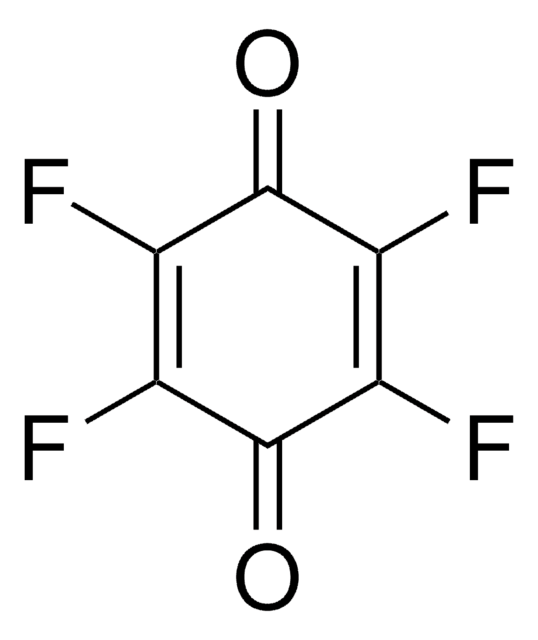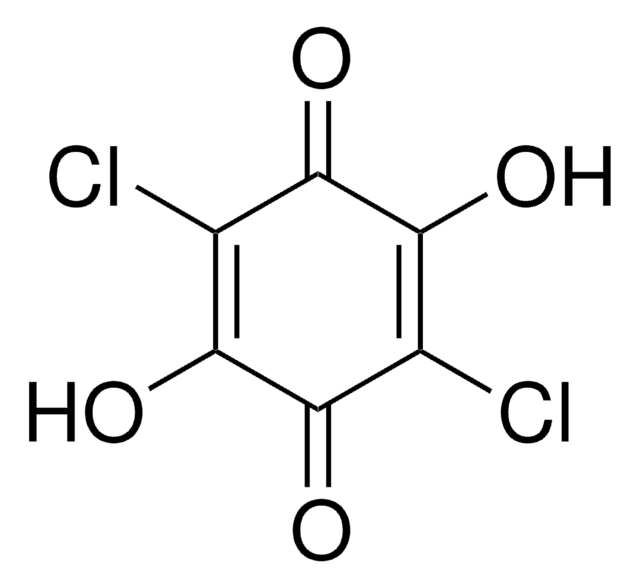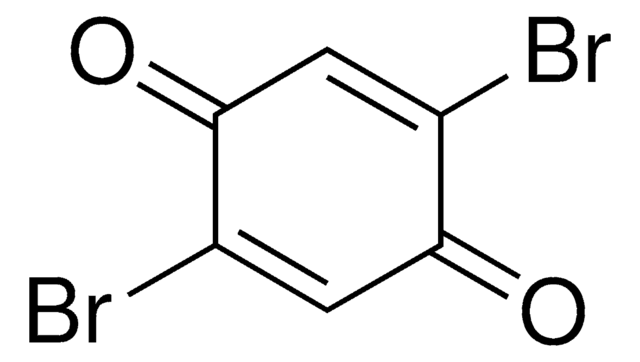おすすめの製品
品質水準
アッセイ
98%
mp
122-124 °C (lit.)
SMILES記法
ClC1=CC(=O)C=C(Cl)C1=O
InChI
1S/C6H2Cl2O2/c7-4-1-3(9)2-5(8)6(4)10/h1-2H
InChI Key
JCARTGJGWCGSSU-UHFFFAOYSA-N
関連するカテゴリー
詳細
2,6-ジクロロ-1,4-ベンゾキノン(DCBQ、2,6-DCBQ)はハロベンゾキノンです。ハロベンゾキノンは、飲料水に含まれる消毒副産物(DBP)です。それらは、活性酸素種を生成し、T24ヒト膀胱癌細胞のタンパク質とDNAに酸化的損傷を誘発することができます。飲料水中のDCBQの紫外線誘発変換が報告されています。液体クロマトグラフィーESIタンデム質量分析による飲料水中のDCBQの検出が報告されています。
アプリケーション
2,6-ジクロロ-1,4-ベンゾキノンは、シングルポテンシャルステップクロノアンペロメトリーによるアセトニトリル中のキノン、芳香族ニトロ化合物、フェロセンおよび芳香族炭化水素化合物の拡散係数(D)を評価する研究での使用に適した試薬です。以下の調製に使用される場合があります。
- 2,3,5-トリクロロ-1,4-ジヒドロキノン
- 2,3,5-トリクロロ-1,4-ベンゾキノン
- 2,6-ジクロロ-1,4-ジヒドロキノン
シグナルワード
Warning
危険有害性情報
危険有害性の分類
Eye Irrit. 2 - Skin Irrit. 2 - STOT SE 3
ターゲットの組織
Respiratory system
保管分類コード
11 - Combustible Solids
WGK
WGK 3
引火点(°F)
Not applicable
引火点(℃)
Not applicable
個人用保護具 (PPE)
dust mask type N95 (US), Eyeshields, Gloves
適用法令
試験研究用途を考慮した関連法令を主に挙げております。化学物質以外については、一部の情報のみ提供しています。 製品を安全かつ合法的に使用することは、使用者の義務です。最新情報により修正される場合があります。WEBの反映には時間を要することがあるため、適宜SDSをご参照ください。
Jan Code
431982-VAR:
431982-BULK:
431982-5G:
431982-10G:
431982-1G:
この製品を見ている人はこちらもチェック
Jinhua Li et al.
Toxicological sciences : an official journal of the Society of Toxicology, 141(2), 335-343 (2014-05-09)
Halobenzoquinones (HBQs) are a new class of drinking water disinfection byproducts (DBPs) and are capable of producing reactive oxygen species and causing oxidative damage to proteins and DNA in T24 human bladder carcinoma cells. However, the exact mechanism of the
Kai He et al.
Journal of hazardous materials, 351, 98-107 (2018-03-10)
Anthropogenic compounds accidentally released to the environment could be important precursors of disinfection byproducts (DBPs) in drinking water treatment processes. In this study, the haloacetic acid formation potentials (HAAFPs) of 155 anthropogenic compounds listed on the Japanese pollutant release and
A Magnuson et al.
Biochemistry, 36(11), 3254-3261 (1997-03-18)
The binding of Mn2+ to manganese-depleted photosystem II was investigated after chemical modification of histidyl and carboxylic acid residues in the presence or absence of the native manganese cluster. K(M) values for Mn2+ were determined from steady-state electron transfer between
Masako Iwai et al.
Photosynthesis research, 87(3), 313-322 (2006-05-16)
PS II-H is a small hydrophobic protein that is universally present in the PS II core complex of cyanobacteria and plants. The role of PS II-H was studied by directed mutagenesis and biochemical analysis in the thermophilic cyanobacterium Thermosynechococcus elongatus
A toxic disinfection by-product, 2,6-dichloro-1,4-benzoquinone, identified in drinking water.
Feng Qin et al.
Angewandte Chemie (International ed. in English), 49(4), 790-792 (2009-12-22)
ライフサイエンス、有機合成、材料科学、クロマトグラフィー、分析など、あらゆる分野の研究に経験のあるメンバーがおります。.
製品に関するお問い合わせはこちら(テクニカルサービス)













